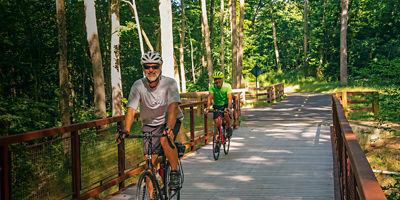
While most people focus on building fitness and learning good technique for the climb, it’s important to prepare for the descent, too. Here’s how to stay safe and in control when heading downhill, whether it’s on the road or remote backwoods singletrack.
DO: Look where you’re going
Look ahead through turns as you descend, watching for oncoming obstacles. Avoid looking down at your front tire; you won’t have enough time to react to potential hazards ahead.
DON’T: Stare at an obstacle
Avoid “target fixation,” where you stare at an approaching obstacle and ride right into it. Your bike will go where you’re looking. Identify obstacles and navigate past them by focusing on where you want to go, not on what you want to avoid.
DO: Use your body position to adjust your speed
Your brakes aren’t the only thing controlling your speed; your body has a significant effect on your velocity, too. To help slow your descent, become “big” on your bike by pushing your chest up to catch the wind like a sail. To speed up, tuck into an aerodynamic position. Bend your elbows and lower your head over the bike’s stem so that your body cuts through, rather than catches, the air.
DON’T: Stay in the same gear
As you pick up speed, shift through the gears until you’re on your biggest ring in the front and your smallest ring in the back. When you run out of gears and your legs just spin without propelling you any faster, rely on body position to add any more speed. Be ready to shift back down when you approach slight uphills or after slowing down.
DO: Keep it straight when the road or trail gets messy
When you encounter slippery road or trail conditions, like mud, sand, or wet leaves, try to go straight through them, with your bike upright. If you have to turn through a slippery area, aggressively slow down before you reach the low-friction surface.
DON’T: Stay on the hoods
If you have drop handlebars, put your hands on the bottom portion of the bars. This will lower your center of gravity, give you better control, and allow you easier access to the brakes—especially if you need to pull them hard. Regardless of the type of handlebars you have, grip them but always keep two fingers over your brake levers. That way, you won’t need to adjust your positioning to slow down.






















